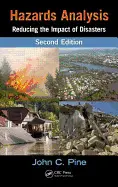- Editorial:
- TAYLOR & FRANCIS
- Materia:
- Ciencia - STEM
- ISBN:
- 978-1-4200-7038-5
NATURAL HAZARDS ANALYSIS
REDUCING THE IMPACT OF DISASTERS
JOHN C. PINE
Emphasizes Resilient Policies, Rather Than Rigid Philosophy
Economic and environmental consequences of natural and man-made disasters have grown exponentially during the past few decades. Whether from hurricanes, chemical spills, terrorist incidents, or other catastrophes, the negative impacts can often be felt on a global scale. Natural Hazards Analysis: Reducing the Impacts of Disasters evaluates critical preparedness issues that emergency managers must face before, during, and after disasters of any kind.
Using a cross-disciplinary approach, this book effectively demonstrates how to use the results of GIS tools, spatial analysis, and remote sensing to reduce adverse disaster outcomes and to foster social, economic, and environmental sustainability. Complete with clearly set objectives, key terms, discussion questions, satellite images and maps, and ancillary websites for further study, this authoritative guide covers every element of the hazard analysis process in a step-by-step format.
Provides Framework for Understanding Hazard Consequences in Variety of Environments
This handbook-style volume stresses the key roles problem solving, decision making, and risk communication serve as means of ensuring all hazard elements are accurately identified and appropriately addressed. It is filled with proven techniques for effective community planning and hazard mitigation and for ongoing restorative efforts in disaster-ridden areas. In one comprehensive source, this book contains all the information needed to analyze risks and establish successful disaster prevention and relief strategies prior to a disaster event.
This resource provides ready-to-implement tools that will benefit for a wide audience, including:
National, federal, and local emergency management teams
Environmental planning professionals in the public and private sectors
Recovery response entities including the Red Cross and Salvation Army
Students enrolled in university emergency management programs









